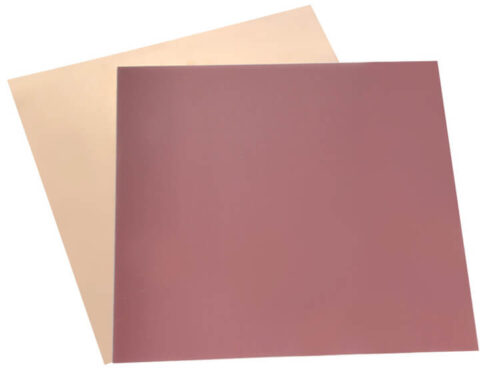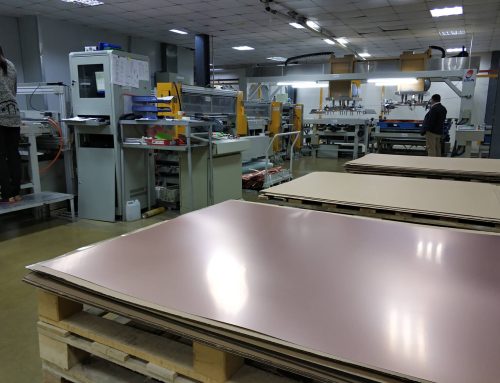In the production of epoxy resin CCL, FR-4 CCL has maintained its dominant position. According to reports, the main reason is that this product has excellent overall performance and flame resistance, but also has a better function-price ratio, by the user’s welcome.
FR-4 Resin glue
Resin glue formula in the epoxy resin CCL industry, FR-4 CCL has been produced for many years, resin glue formula is basically the same.
Preparation method
Dimethylformamide and ethylene glycol methyl ether, stirring mixing, dubbed mixed solvent.
Adding dicyandiamide, stirring dissolved.
Adding epoxy resin, stirring mixing.
Monomethylimidazole was dissolved in an appropriate amount of dimethylformamide beforehand and added to the above-mentioned materials, and stirring was continued well.
Parked (mature) 8h, selecting the samples and test the relevant technical requirements.
Technical requirements for resin glue.
Solid content of 65% to 70%.
Gel time (171℃ ) was 200-250 seconds.
Adhesive sheet
Manufacturing process
After glass fiber cloth opening roll, passed the guide roller, into the plastic tank. After dipping by squeezing the rubber roller, control the resin content, and then into the oven. During the oven, volatiles, such as solvents, are removed, while the resin is in a semi-cured state. After the oven, according to the size requirements of shear, and neatly stacked on the storage rack. Adjusting the gap between squeeze rollers to control the resin content. Adjusting the oven temperature, air flow and speed control gel time and volatile matter content.
Detection method: in manufacturing process of the adhesive sheet , in order to ensure quality, must be regularly on the technical requirements for testing. The detection method is as follows:
Resin content
At least 25 mm from the edge of the adhesive sheet, cut three samples in the width direction left, center and right. Sample size is 100mm × 100mm, the diagonal lines are parallel to the latitude and longitude.
Weighing by weight (W1), accurate to 0.001g.
The sample is placed in 524-593 (the muffle furnace, burning more than 15min, or burn until the carbide completely removed.
The sample was transferred to a desiccator and cooled to room temperature.
Weighing by weight (W2), accurate to 0.001g
Calculation: Resin content = [(W1-W2) / W1] × 100%
FR-4 Application
FR4 epoxy glass fiber board (epoxy board), the main material is import prepreg, color is white, yellow, green, it still have high mechanical strength under the normal temperature of 150 ℃ in room temperature, has good electrical performance in dry, wet conditions, flame retardant, used in electrical, electronic and other industries insulation structure parts, using imported raw materials, domestic compressor and standard manufacturing process, the main specifications are 1000*2000 mm,1020mm*1220mm, because of the advantages of raw materials, to ensure the quality and cheap, the quality of the products, timely delivery, are widely used in electrical, have stable customers at home and abroad, and enjoy a high reputation.
FR-4 CCL, FR-4 yellow color, white color, FR-4 Epoxy Glass Cloth Laminated Sheet, according to the different application, the industry generally known as FR-4 Epoxy Glass Cloth、Insulation Board、Epoxy Board、Epoxy Resin board、Brominated epoxy resin board、FR-4、Fiberglass board、Glass fiber board、FR-4 reinforced board、FPC reinforced board、Flexible board reinforced board、FR-4 epoxy resin board、Flame – retardant insulation board、FR-4 Laminated Sheet、Epoxy Glass Cloth Board、FR-4 light board、FR-4 glass fiber board、Epoxy glass cloth plate、Epoxy glass cloth laminated board、PCB board drilling plate.
Main technical characteristics and applications: stable electrical insulation、flatness、smooth surface、no pits、thickness tolerance standards、suitable for high-performance electronic insulation products, such as FPC reinforced board、PCB drilling plate、Glass fiber meson、Potentiometer Carbon Fibre Printed Fiberglass Plates, Precision Planetary Gears (Wafer Grinding)、Precision Testing Plates、Electrical (Electrical) Equipment Insulation Strip Baskets、Insulation Boards、Transformer Insulation Boards、Motor Insulators、Grinding Gears 、Electronic switch insulation board, etc.
High temperature insulation material (FBR1802-1806 series)
Far-infrared heating plate (FR-4 FBR-1801)
Insulation materials(FR-4)
Epoxy resin board(FR-4)
CCL(FR-4)
Insulation materials (insulation board, epoxy board, CCL, FR-4, circuit boards, phenolic board)
FR-4 manufacturing
Recommended multi-plate platen procedures
Surface preparation and treatment
Copper surface is through the graphics and etching circuit, try to reduce the PTFE surface treatment and contact. Operators should wear clean gloves and put the interlayer film on each board for transfer to the next procedure.
The etched PTFE surface has sufficient roughness to bond. Where the foil is etched or where the laminate is not to be covered, it is recommended that the PTFE surface be treated to provide adequate adhesion. The chemical composition used in the preparation of pth can also be used for surface treatment.Plasma etching or sodium-containing chemical agents such as FluroEtch® by Acton,TetraEtch® by Gore, and Bond-Prep® by APC are recommended. Specific processing technology are provided by suppliers.
Copper surface treatment should ensure the best adhesion strength. The brown copper oxide circuit treatment will strengthen the surface shape to facilitate chemical bonding using TacBond adhesives. The first process requires a cleaner to remove residual and process oil. Next make small copper etching to form a uniform rough surface area. The brown oxide needle-like crystals stabilize the adhesive layer during lamination. As with any chemical process, adequate cleaning after each step is required. Salt residue inhibits adhesion. The final rinse should be monitored and maintained at a PH of less than 8.5. Dry layer by layer and ensure that the surface is not contaminated with oil or the like.
Superposition and lamination
Recommended bonding (pressing or pressing board) Temperature: 425℉(220℃)
250º F(100℃) baking plate layer to remove moisture. Laminate is stored in a tightly controlled environment and used within 24 hours.
Palette should be used between the first electrolytic plate pressure field in order to make the pressure in the control panel can be evenly distributed. Exists in plate and the high pressure area will be populated circuit boards will be absorbed by the field. The field also allows the temperature from the outside to the center to be unified. Thereby forming a uniform thickness between the control board and the control board.
The plates shall consist of TAC BOND sheet provided by the supplier. Care should be taken to prevent contamination when cutting thin layers and stacking. Depending on the circuit design and filling requirements, one to three adhesive layers are required. The area to be filled and dielectric requirements are used to calculate the demand for 0.0015 “(38 micron) sheets. It is recommended to use clean steel or aluminum plates between the laminates.
To aid in lamination, a vacuum treatment was performed for 20 minutes before heating. The entire cycle is maintained in a vacuum state. Air evacuation will help ensure the completion of the circuit package.
The thermocouple was placed in the peripheral area of the center plate can be used to determine the temperature monitoring and the appropriate period
The plate can be mounted on a cold or preheated press platen and started. If don’t use the pressure field to compensate, the heat rise and cycle will be different. It is not critical that the heat input to the package, but should be controlled to minimize the gap between the periphery and the central area. Typically, the heat rate is between 12-20ºF/min(6-9℃/min) to 425º F(220℃).
Once loaded into the pressing machine, the pressure can be applied immediately. The pressure will also vary with the size of the control board. Should be controlled within the range of 100-200 psi (7-14 bar).
Keep the hot pressing at a high temperature of 425º F(230℃) for at least 15 minutes. The temperature shall not exceed 450º F(235℃).
In the lamination process, the time to reduce the pressure-free state (such as the time from the hot pressing to the cold pressing) is minimized. Keep the pressure state and pressure below 200º F(100℃).
More products informations, please contact [email protected], we have a specialized technical engineers service for you, at the same time we can offer you free samples.


